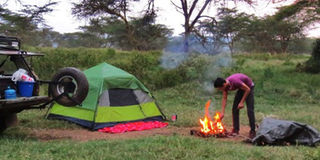Camping rough in a premium park

PHOTO | JAN FOX Getting a fire going at the Rhino Special Campsite in the heart of Lake Nakuru National Park.
Last week I wrote about Camp Carnelley’s and its very chilled-out restaurant. I was passing through Naivasha en route to Lake Nakuru where a friend and I planned on camping for a couple of nights.
Pitching your tent in the heart of Lake Nakuru National Park offers a very different experience to a night at Carnelley’s. In Naivasha, an electric fence separates you from grazing hippos at night; in Nakuru, you are completely exposed to the park’s wildlife — shielded only by rivers and any other natural boundaries surrounding your campsite (though baboons make a lot of noise when they spot predators, and make excellent askaris). And, as luck would have it, the campsite we chose on our first night had a resident troupe keeping watch.
Lake Nakuru National Park is one of the Kenya Wildlife Service’s ‘Premium Parks’— along with Amboseli — and it’s easy to see why. The lake shores, dense acacia forests and open plains, are home to a diversity of wildlife, and the high ‘baboon cliffs’ along its western edge offer spectacular views across the park. Its relative proximity to Nairobi is another bonus; Nakuru is only 160 km from the capital.
The only downside is the price, but only for non-residents. $80 (Sh7,000) a day is quite a big hit, and so too is the extra $25 (Sh2,200) to camp. It was such a big hit for my companion, in fact, that we had to head back to Nairobi instead of further on to Lake Bogoria after our stay in Nakuru.
There are, of course, benefits of charging such high prices for non-residents. The revenue generated facilitates the conservation of Kenya’s parks, and the low resident and citizen rates act as an incentive for more Kenyans to visit them too.
KWS should be flexible with the fees, however. When we arrived at the main gate in Nakuru, the water level of the lake was so high that part of the compound was submerged. As a result the entire route around the north of the lake was inaccessible, and so too were a number of roads heading south — including the popular circuit across the lake’s southern shores.
The Makalia River had burst its banks too, so we had to scout for an alternative route to our campsite. And for those in saloon cars, camping seemed to be the only option as the main road to the lodges was largely underwater. I had heard that the area around Lake Baringo was flooded as well, and most of its lodges were closed. Perhaps the KWS should consider reducing their rates in such scenarios — when a considerable proportion of the park is inaccessible.
There are campsites dotted all over the park. The best by far is the somewhat elusive Makalia campsite at a great location in the park’s southern tip. It lies on the banks of the Makalia River, and a large waterfall that feeds it. This was our first choice, but when a huge overland truck parked next to our tent and dozens of Spanish tourists streamed out of it, we decided to find a quieter spot. We settled for one of the many ‘special campsites’, which are almost always empty. The one we chose still straddled the Makalia River, but was open to the southern plains and a large herd of buffalo grazing off it.
The following day we packed up and headed out for an early morning game drive. Although it isolated parts of the reserve, the high level of the lake did have its advantages. Most of the wildlife had been forced further south and was now concentrated in the area where we camped, so we didn’t have to drive far.
Although we couldn’t find any this time, Nakuru was where I spotted my first leopard — after 20 years of scouring Kenya’s national parks. The acacia forest presents the perfect habitat for them.
Although there are no elephants in the park, Nakuru is a great place to spot the rest of the big five. Rhinos, in particular, are in abundance, and we spotted both black and white rhinos, though in somewhat disturbing circumstances.
Early on our second day we spotted a dead white rhino next to a KWS vehicle. For four hours we watched as dozens of rangers arrived at the scene and began to carry out a post-mortem by meticulously carving the rhino open. According to one of the rangers, it had been killed by another male, though they seemed to be searching for something in the carcass with a metal detector.
Maybe KWS will issue a statement soon to shed light on what actually happened.
Either way, it made for a very interesting game drive, and it capped a great couple of days camping.
So next time you plan a trip to Lake Nakuru National Park, save some money and consider taking your tent.
If you go:
Lake Nakuru National Park
Citizens: Sh1,000
Residents: Sh1,000
Non-Residents: $80
Camping Fees:
Public campsites (Makalia and Njoro)
Citizens: Sh200
Residents: Sh500
Non-Residents: $25
Special campsites:
Citizens: Sh400
Residents: Sh500
Non-Residents: $40




